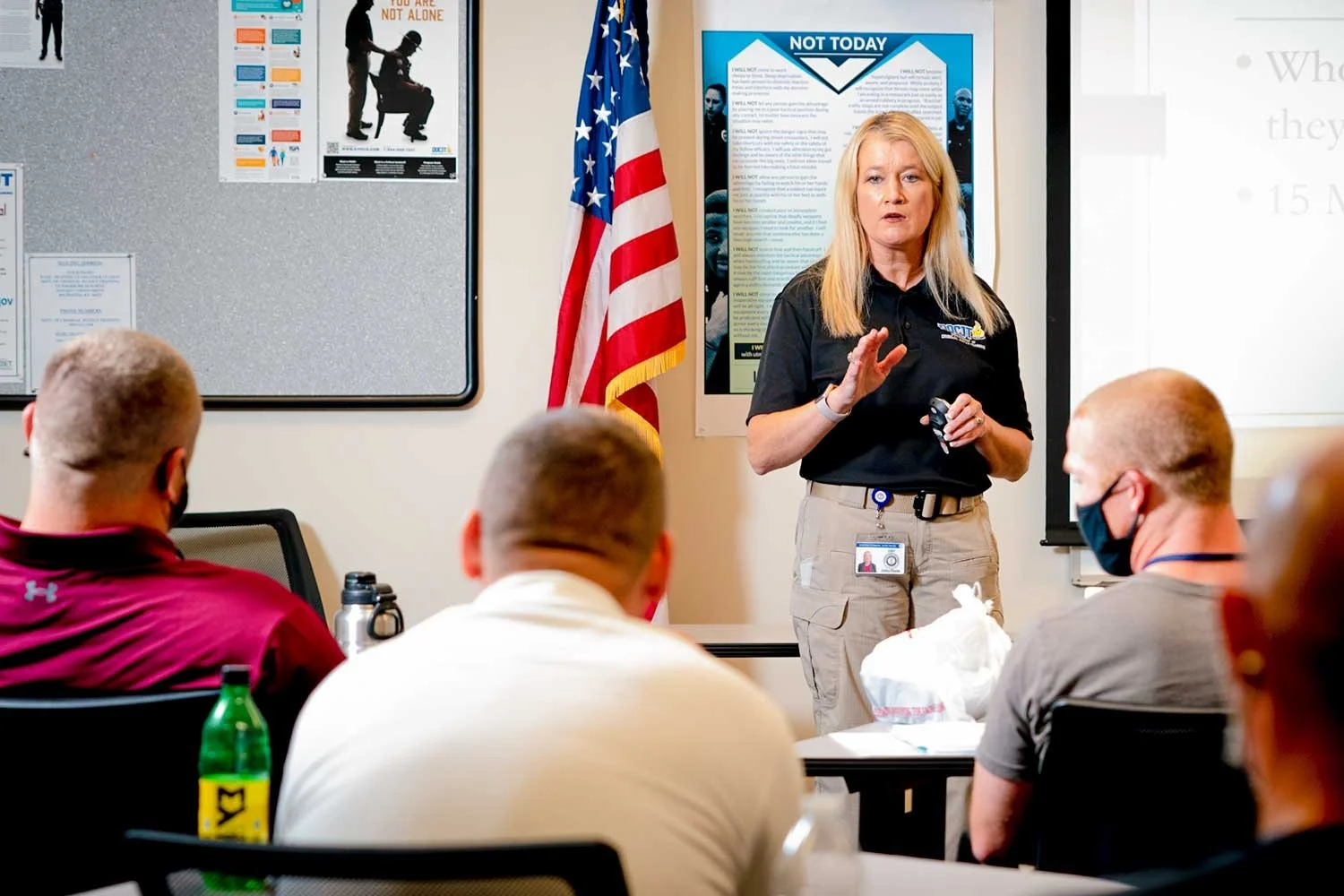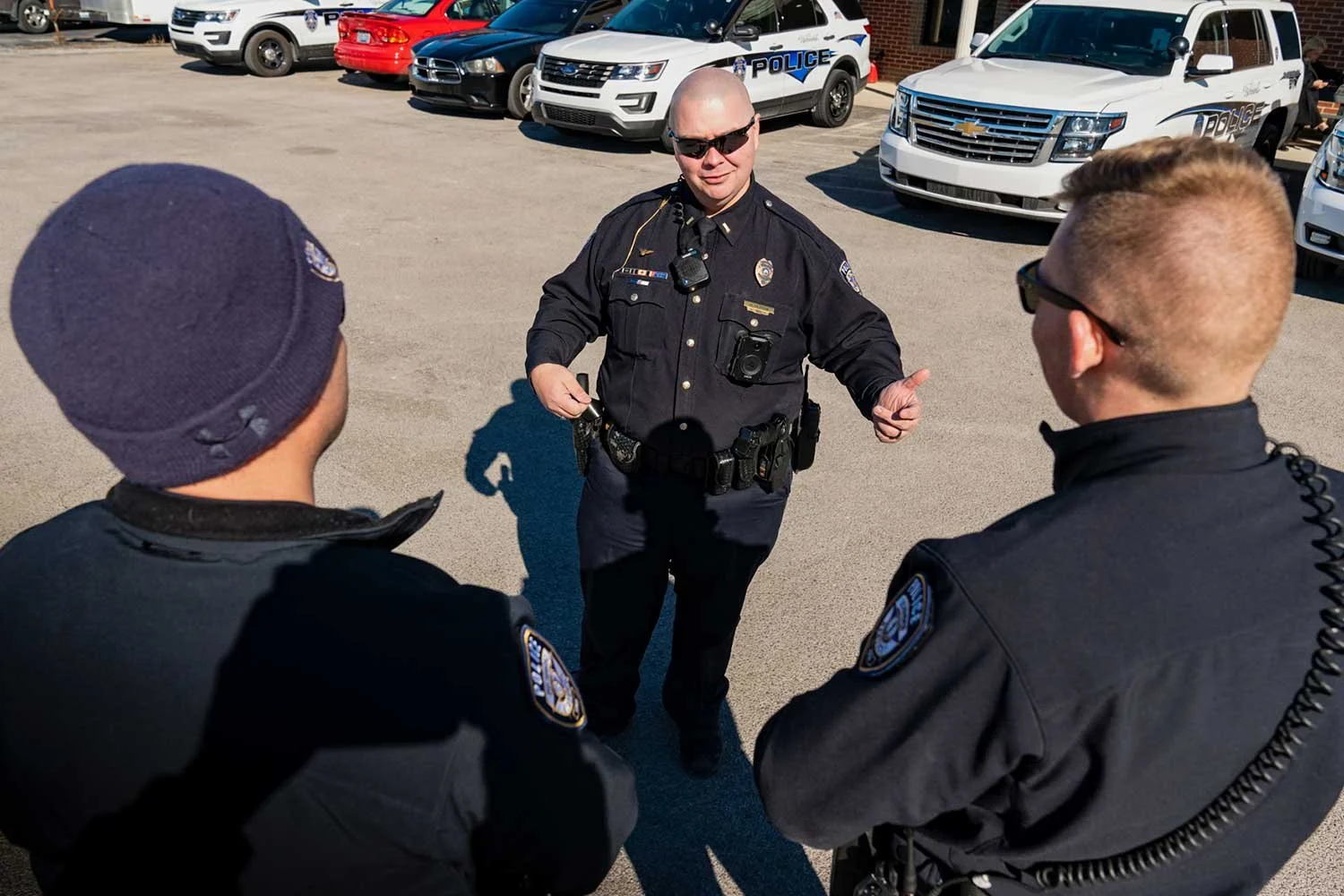Continuing Education
PICTURED ABOVE
Richmond Police Training Officer Jason Friend (in the driver’s seat) gives pointers to Officer Hunter McFerron, a trainee in the department’s PTO program. (Photo by Jim Robertson)
Through the Department of Criminal Justice Training and other law enforcement instructional agencies, officers in the commonwealth receive top-notch basic training.
However, graduation doesn’t mean training is done. Many Kentucky agencies take what recruits learn and build on it through Field Training Officer (FTO) or Police Training Officer (PTO) programs.
Though similar, there are differences between a PTO and FTO program, said DOCJT Leadership Instructor Cathy Eaves. We have developed a hybrid of both programs, called the Law Enforcement Training Officer Class, so that officers can take back what works best to their agencies.
“The PTO program deals with problem-based learning where the new officer is presented with real-life issues and works through them to come up with a solution,” she said. “With the FTO program, you have more of a hands-on approach. It often entails memorization. I tell you to do something, and you memorize how to do it, or physically demonstrate how to do it.”
Eaves said no matter what program an agency goes with, it does nothing but enhance the individual officer.
“These programs are critical because your officers need to be on the same page regarding training and the legal liability involved,” Eaves explained. “Each agency has its own set of policies and procedures that they follow.”
Successful Program
Eaves said a successful FTO/PTO program begins with those conducting the training.
“It starts with (the agency’s training) officers,” she said. “They should have the same set of training, but (the new officer) will get a different aspect from each trainer. That’s beneficial because you can learn from their different personalities, but you are still following the same policy and procedures.”
DOCJT Leadership Instructor Cathy Eaves (Photo by Jim Robertson)
The training officers should be well-versed in leadership, Eaves said.
“They need to be knowledgeable regarding their agency’s policy and procedures and the Kentucky Revised Statutes,” Eaves pointed out. “They also need to be of high character and moral ethics.”
Richmond Police Lt. Daniel Deaton, who oversees his agency’s PTO program, said those who serve as training officers also must realize going in that they are not in that position to be the trainee’s friend.
“If they get to the end of training and they’re not hacking it as a police officer, and they have to be let go, we look back at what they put down in the daily observation report (DOR),” Deaton said. “If the PTO says this person doesn’t need to be a cop, it needs to be justified in the DOR. Everything has to be documented. If they get into something down the road, and the court pulls all their training records, you have to have good documentation detailing how they were trained.”
Training Phases
A typical FTO/PTO program is broken down into four phases, comprising between 13 and 16 weeks, Eaves said.
Those training phases should cover everything from the importance of serving people in your community and learning the city’s geography to the completion of routine forms and conducting traffic stops.
Deaton said the department took pieces from each program and designed one that offers maximum benefits.
In Richmond, the program breaks down into four, three-week training phases and an additional week with investigations.
Both Deaton and Eaves added that it is important for trainees to rotate different shifts and training officers to gain different perspectives.
Richmond has clearly defined goals and objectives for each phase of training. For example, in Phase I, trainees learn functions such as geography, police radio – codes, usage/etiquette, radio procedures, department procedures, mobile-data terminal familiarization, basic collision investigation and report completion, department forms and paperwork and civil vs. criminal matters.
Each phase builds off the other, and once a trainee reaches Phase IV, the officer should be able to handle any call with minimal or no assistance.
Establishing a Program
While many law enforcement agencies in Kentucky already have PTO or FTO programs in place, there are still many that do not.
DOCJT makes it easy for those agencies that would like to establish a program to do so, Eaves said.
DOCJT Leadership Instructor Cathy Eaves said FTO-PTO programs are essential to any agency because officers need to be on the same page regarding training. (Photo by Jim Robertson)
DOCJT offers a 40-hour Law Enforcement Training Officers Class, which covers various topics, including Legal, Adult Learning, Coaching and Mentoring, Basic Overview (to see what the academy is teaching recruits), and Documentation. The class is designed with PTO and FTO trainers in mind.
“We do this because we’ve learned that many agencies will combine those programs to create a hybrid. There are a lot of great concepts that we use,” Eaves said. “With PTO, you have the problem-based learning that walks officers through problems they may encounter so they can work through them on their own.
“In addition, we have the neighborhood portfolio exercise, which teaches them geography and how to build relationships within their communities to solve problems,” she continued. “We incorporate that with community-based policing to solve issues they will face within their communities. With FTO, it’s more of a hands-on approach. It’s about memorization. The trainer will teach the trainee something and have them demonstrate that they understand it.”
The course also includes a four-hour block of legal training on vicarious liability and other legal issues.
They have the opportunity to observe recruits in the academy during different scenario-based training, Eaves said.
“They can see what they are learning and how they are reacting to the training,” she said. “We find that beneficial because we get to see how these officers react during training.”
The training also incorporates emotional intelligence (self-awareness and self-control) and generational differences.
“We’re seeing more millennials and Gen-Zs coming into law enforcement,” Eaves said. “They have a different way of doing things than we did when we were younger.”
DOCJT also provides agencies with examples of different policies that other agencies have incorporated throughout the state to set up a program.
Richmond Lt. Daniel Deaton speaks with Police Training Officer Jason Friend, left, and Officer Hunter McFerron in the parking lot of RPD. (Photo by Jim Robertson)
Benefits
Ultimately, the PTO and FTO training, coupled with law enforcement basic training, helps set a solid foundation for officers to build their career and become an asset to their agency and community.
Additionally, properly trained officers lessen the chance that an agency will be involved in a lawsuit in the future, Eaves said.
Deaton added that a properly trained officer is generally a safe officer.
“There are only so many scenarios the academy can prepare you for,” he said. “The PTO/FTO program will help the person learn to develop that ‘gut feeling’ about when something is about to go wrong.
“It provides an opportunity to see how the officer reacts in the field, and it allows them to work with somebody who has the experience and who has worked these types of calls,” he continued. “The training will help limit mistakes in the field, and it is also about officer safety, as well.”








